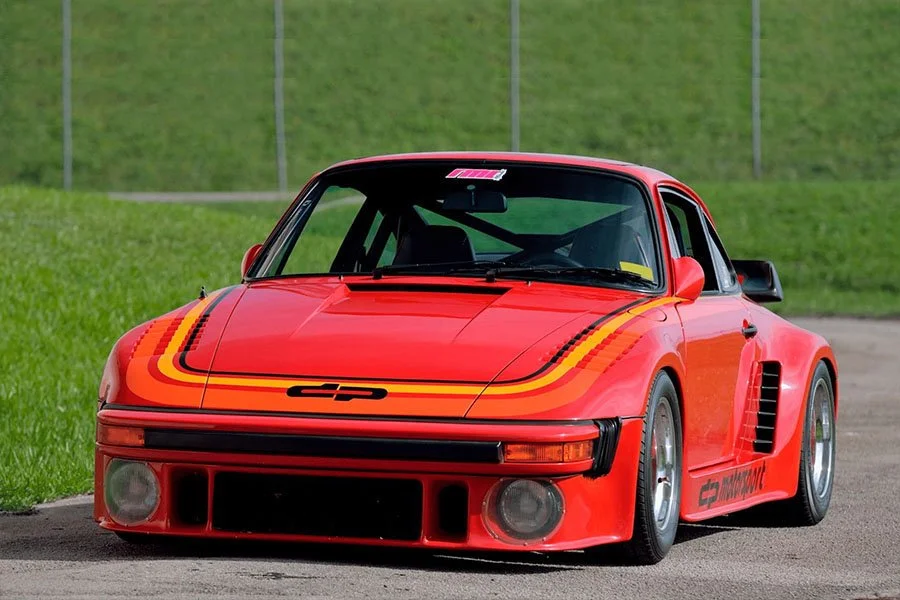VIN: the Martini Racing / Brumos Racing / Hector Rebaque Porsche 911 3.0 Carrera RSR chassis 9113600686 R7
/HISTORY OF CHASSIS 9113600686 R7
Chassis 9113600686, also known as R7, was the last of Porsche’s eight R-numbered 911 RSRs to appear during the 1973 season.
R7 made its competition debut alongside sister car R5 at the Nurburgring 1000km which was round seven of the 1973 World Sportscar Championship and took place on May 27th. It was entered in the Group 5 class for Herbert Muller / Gijs van Lennep while R5 ran in the Group 4 category.
The new car debuted a re-shaped back end designed to take massive new centre-lock wheels with titanium hubs and, thanks to its fibreglass body, R7 was now considerably lighter than a Group 4 RSR.
Muller / van Lennep qualified R7 in 15th and, despite a poor start, the car gradually made its way through the field to eventually cross the line fifth overall.
R7 next appeared two weeks later for the Le Mans 24 Hours (round eight, June 9th and 10th) where it was again allocated to Muller / van Lennep. Also on hand was R6 which had been uprated to a similar specification (for Reinhold Joest / Claude Haldi) while the old R2 was loaned to French Porsche distributor Sonauto and ran in the Group 4 class with Peter Gregg / Guy Chasseuil behind the wheel.
Muller / van Lennep qualified 18th with the sister car of Joest / Haldi 19th.
By the three hour mark, R7 had moved to comfortably within the top ten and, at mid-distance (4am), things were looking good for a strong finish with Muller / van Lennep now up to fifth. R7 continued to run like a train until the end; it ultimately placed fourth overall behind a trio of works prototypes from Matra and Ferrari.
R7’s final outing in Martini Racing colours came at the penultimate World Championship event of 1973: the Zeltweg 1000km on June 24th (round nine).
By this time, Porsche had developed a revised rear body section with a large faired-in spoiler that extended well beyond the rear bumper and featured two vertical stabilising fins. A new flat front apron had also been created. R6 ran the new configuration while R7 adopted the new front apron but was otherwise as it had appeared at Le Mans.
On this occasion, R7 was allocated to Helmuth Koinigg and Manfred Schurti.
Both cars ran like clockwork in what proved an uneventful race for Porsche. They quickly moved up to seventh (Muller / van Lennep, R6) and eighth (Koinigg / Schurti, R7) but each chassis had dropped a position by the chequered flag.
For the last World Sportscar Championship race of 1973 (the Watkins Glen 6 Hours on July 21st), R7 was loaned to Peter Gregg’s factory-supported Brumos Racing outfit while R6 went to Roger Penske. Both cars ran the long tail body which since Zeltweg had been updated with an adjustable central plane between the fins which yielded much-improved handling and downforce.
The two Group 5 cars qualified tenth (Penske) and eleventh (Brumos). They went on to run nose-to-tail until quarter distance when Gregg (who was driving R7 with Hurley Haywood) limped into the pits with a broken driveshaft that took ten minutes to fix.
Chassis R6 ultimately came home sixth while R7 placed seventh.
The next day (July 22nd), Watkins Glen hosted a 60 lap Can-Am race (round three of the 1973 series) for which R7 was the only GT-style car entered.
Against a field of super lightweight Group 7 cars, Peter Gregg managed to out-qualify a couple of two-year old privateer McLaren M8Fs to line up 19th on the 21 car grid. He went on to finish a creditable ninth overall.
The factory subsequently tasked Porsche dealer Gregg with finding a buyer for chassis R7.
In 1974 it passed to Mexican privateer Hector Rebaque who also acquired chassis R6. Rebaque campaigned the car in white and red Viceroy cigarettes livery during that year’s Le Mans 24 Hours (DNF, ignition), the Zeltweg 1000km (14th overall, sixth in class) and the Mexico City 1000km IMSA race (eleventh overall, ninth in class).
Rebaque retained R7 until 1977, at which point it passed through the hands of Gonzalo Baca Spross and then quickly on to Massimo Baliva in Italy who retained it until 2012.
Notable History
Martini Racing Team
27/05/1973 WSC Nurburgring 1000km (G. van Lennep / H. Muller) 5th oa, 4th S3.0 class (#6)
10/06/1973 WSC Le Mans 24 Hours (G. van Lennep / H. Muller) 4th oa, 4th S3.0 class (#46)
24/06/1973 WSC Zeltweg 1000km (H. Koinigg / M. Schurti) 9th oa, 9th S3.0 class (#8)
Loaned to Peter Gregg / Brumos Racing (White, Blue & Red Brumos livery)
21/07/1973 WSC Watkins Glen 6 Hours (P. Gregg / H. Haywood) 7th oa, 7th S3.0 class (#59)
22/07/1973 CAM Watkins Glen (P. Gregg) 9th oa (#58)
1974 sold to Hector Rebaque, Mexico (White & Red Viceroy cigarettes livery)
16/06/1974 WSC Le Mans 24 Hours (G. Rojas / H. Rebaque / F. van Beuren Jr.) DNF (#46)
30/06/1974 WSC Zeltweg 1000km (G. Rojas / H. Rebaque / F. van Beuren Jr.) 14th oa, 6th GT2.0+ class (#40)
20/10/1974 IMS Mexico City 1000km (G. Rojas / H. Rebaque / F. van Beuren, Jr.) 11th oa, 9th GTO class (#5)
1977 sold to Gonzalo Baca Spross, Guatemala
1977 sold to Massimo Baliva, Italy
Retained until 2012
Text copyright: Supercar Nostalgia
Photo copyright: Porsche - https://www.porsche.com































